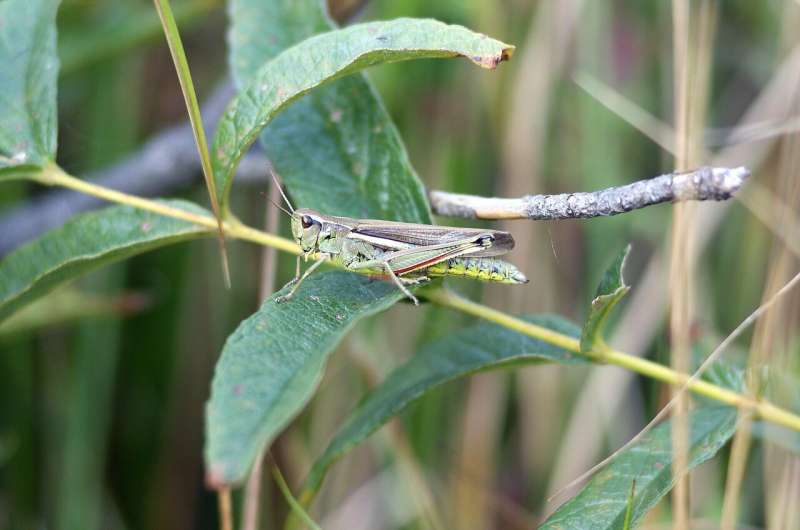Crucial benefits of vital moorland restoration works revealed

The innovative Mires on the Moors project has made significant breakthroughs in the quest to identify where peatlands, found on the Moors across the United Kingdom’s South West, have been damaged by drainage, peat cutting and burning.
The long-term collaboration, underpinned by a series of high-profile research studies, has not only established what condition these peatlands are in, but also how they can be restored to function more naturally.
The significant findings include demonstrating peatland restoration can bring substantial and meaningful changes, almost immediately, to increasing water storage.
This, in turn, can bring positive changes to water quality and greenhouse gas losses to the atmosphere—resulting in more carbon being locked up in peatlands.
Crucially, the project has also shown that peatland restoration need not impact negatively on upland farming across the region—a significant outcome not just for the farmers directly, but also for water companies and society as a whole.
The Mires on the Moors project is delivered in partnership with a range of organizations, including the University of Exeter, South West Water, the Environment Agency, Natural England, Historic England, Dartmoor National Park and Exmoor National Park.
The findings of the collaborative project can be found in a special report.
Professor Richard Brazier, Director, Centre for Resilience in Environment, Water and Waste (CREWW), said, “The Mires on the Moors report is the culmination of a decade of research into the impacts of moorland restoration on the hugely important landscapes of Dartmoor and Exmoor.
“As the report and the peer reviewed papers which underpin it demonstrate, restoring healthy functioning peatlands is critical in the fight against climate change, as healthy peatlands lock up carbon by forming more peat. They also release cleaner water, reducing treatment costs and less water in times of heavy rainfall, which reduces flood risk downstream.
“The research has been made possible not only by funding from SWW, but also via support from a wide range of organizations, who have come together to demonstrate the positive environmental progress that can be made from genuine partnership working.
“It has been a real highlight of the work to engage with so many people who understand the value of our natural resources and the importance of not just preventing further degradation, but actually enhancing our landscapes for future generations.”
Peatlands are a type of wetland that store more organic carbon than any other type of land ecosystem in the world. Due to waterlogged conditions, dead plant materials do not fully decay and carbon accumulates in peatlands over thousands of years.
Therefore, natural peatlands help to cool the climate by capturing carbon dioxide (CO2) from the atmosphere through photosynthesis and trapping carbon in soils. However, artificial drainage of peatlands for agriculture aerates the soil and enhances the decay of organic matter, rapidly releasing carbon into the atmosphere.
This degraded state of UK peatlands has been recognized as a critical problem in the UK’s bid to meet its targets of carbon storage and Greenhouse Gas Removal.
The South West peatlands of Dartmoor, Exmoor and Bodmin Moor are potentially huge carbon stores, with equal potential to store water at times of heavy rainfall and release cleaner water during times of drought.
The Mires on the Moors project, therefore, was launched to help understand the way in which these peatlands are structured, how they function and how they might respond to restoration practices.
Highlighting the success of the project, more than 27 km² of peatland have been restored following methods specifically developed for Exmoor and Dartmoor. Restoration of deeper peatlands increased the permanent deep-water storage in the soil and increased average water tables, while also significantly altered rainfall runoff regimes in restored catchments.
In deeper peatlands, raised water tables significantly reduced respiration of the peat store and initially increased methane emissions—both processes indicative of a return to more natural functioning in the longer term.
Dr. David Smith, South West Water’s Natural Resources Team Manager, said, “When Ofwat, the water industry regulator, agreed to South West Water undertaking catchment management on land it did not own back in 2009, they also asked that we measure and understand the benefits to water customers. This report begins to do just that, in the headwaters of the catchments where South West Water has invested over 4 million pounds in peatland restoration over the last 10 years.
“The report sets out the impacts so far on water quality, flow and storage, greenhouse gases, biodiversity and farming. A really amazing achievement and one that validates our work to set up the monitoring program with the University of Exeter and Professor Brazier back in 2010.”
Substantial carbon dioxide emissions from northern peatlands drained for crop cultivation
The report on project findings is available as a PDF at www.exeter.ac.uk/media/univers … oors_report_2020.pdf
Citation:
Crucial benefits of vital moorland restoration works revealed (2021, October 11)
retrieved 11 October 2021
from https://phys.org/news/2021-10-crucial-benefits-vital-moorland-revealed.html
This document is subject to copyright. Apart from any fair dealing for the purpose of private study or research, no
part may be reproduced without the written permission. The content is provided for information purposes only.
For all the latest Science News Click Here
For the latest news and updates, follow us on Google News.

